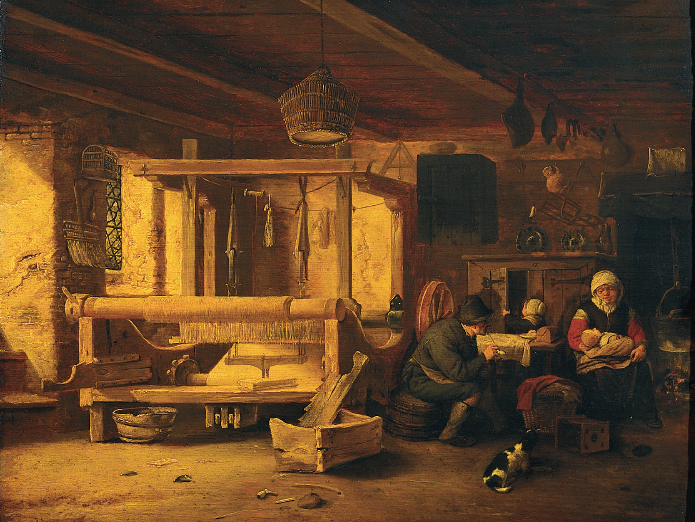Understanding Western Society
Printed Page 527
The Lives of Rural Textile Workers

Until the nineteenth century, the industry that employed the most people in Europe was textiles. The making of linen, woolen, and eventually cotton cloth was the typical activity of cottage workers engaged in the putting-
Handloom weaving was a family enterprise. All members of the family helped in the work. Operating the loom was usually considered a man’s job, reserved for the male head of the family. Women and children worked at auxiliary tasks; they prepared the warp (vertical) threads and mounted them on the loom, wound threads on bobbins for the weft (horizontal) threads, and sometimes operated the warp frame while the father passed the shuttle.
The work of four or five spinners was needed to keep one weaver steadily employed. Since the weaver’s family usually could not produce enough thread, merchants hired the wives and daughters of agricultural workers, who took on spinning work in their spare time. In England, many widows and single women also became “spinsters,” so many in fact that the word became a synonym for an unmarried woman.
Relations between workers and employers were often marked by sharp conflict. There were constant disputes over the weights of materials and the quality of finished work. Merchants accused workers of stealing raw materials, and weavers complained that merchants delivered underweight bales. Suspicion abounded.
Conditions were particularly hard for female workers. While men could earn decent wages through long hours of arduous labor, women’s wages were usually much lower because they were not considered the family’s primary wage earner. In England’s Yorkshire wool industry, a male wool comber earned a good wage of 12 shillings or more a week, while a female spinner could hope for only 3½ shillings.1 A single or widowed spinner faced a desperate struggle with poverty. Any period of illness or unemployment could spell disaster for her and any children she might have.
From the merchant capitalist’s point of view, the problem was not low wages but maintaining control over the labor force. Cottage workers were scattered across the countryside, and their availability for work varied with the agricultural calendar. Merchants bitterly resented their lack of control over rural labor because their own livelihood depended on their ability to meet orders on time. They accused workers — especially female spinners — of laziness, drunkenness, and immorality. If workers failed to produce enough thread, they reasoned, it must be because their wages were too high and they had little incentive to work.
Merchants thus insisted on maintaining the lowest possible wages to force the “idle” poor into productive labor. They also lobbied for, and obtained, new police powers over workers. Imprisonment and public whipping became common punishments for pilfering small amounts of yarn or cloth. For poor workers, their right to hold on to the bits and pieces left over in the production process was akin to the traditional peasant right of gleaning in common lands. With progress came the loss of traditional safeguards for the poor.